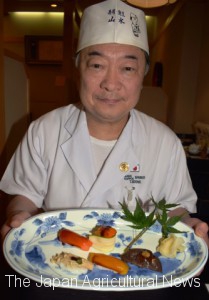Thirty sushi shops in Saitama Prefecture started offering vegetable sushi using only vegetables produced in the prefecture and no seafood.
The sushi industry association in the prefecture took three years to develop the product ahead of the Rugby World Cup scheduled to be held in Japan in 2019 and the 2020 Tokyo Olympics and Paralympics, targeting foreign visitors which are increasing in number, as well as vegetarians and health-conscious people.
The association created a recipe book for sushi chefs in the prefecture and started handing it out in May.
The book lists 40 recipes, including red and yellow bell pepper sushi with sweet soy sauce and sushi rolls filled with chopped tomatoes and balsamic vinegar rolled with sliced zucchini instead of dried seaweed.
The recipes were created by Toshiaki Sekine, 60, head of the association, and other association members. Sekine began serving the sushi in May at his sushi restaurant Sansui located in Kita Ward in the city of Saitama, and some 200 people ordered it in less than a month. He said the restaurant has been getting lots of inquiries on the sushi.
According to Sekine, customers of his restaurant who cannot eat raw fish tend to order grilled fish or rolled omelette. “But they say they can enjoy sushi if they are made of vegetables,” he said.
In creating vegetable sushi, they concentrated on maintaining the vegetables’ flavor and crispy texture by keeping them lightly cooked or mixing them with lemon juice. Sauce is also made from locally-produced vegetables such as basil. Vinegared rice and soy sauce used in sushi go well with vegetables, Sekine said.
Three years ago, Sekine started developing new sushi recipes, thinking that it is not interesting for a sushi restaurant in a landlocked prefecture to serve sushi using only marine products. He focused on vegetables after learning that Saitama is a major vegetable producing area, ranking seventh among prefectures nationwide in terms of vegetable production in 2015.
The association distributed recipe books and menu of sushi using vegetables in season to 120 member shops in the prefecture. The association hopes to spread the recipes by holding cooking classes for
sushi chefs.


